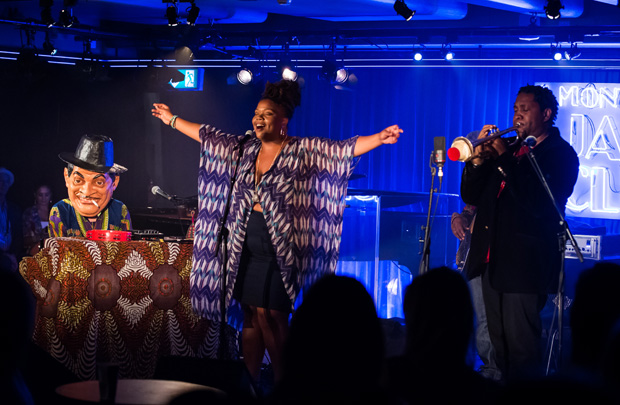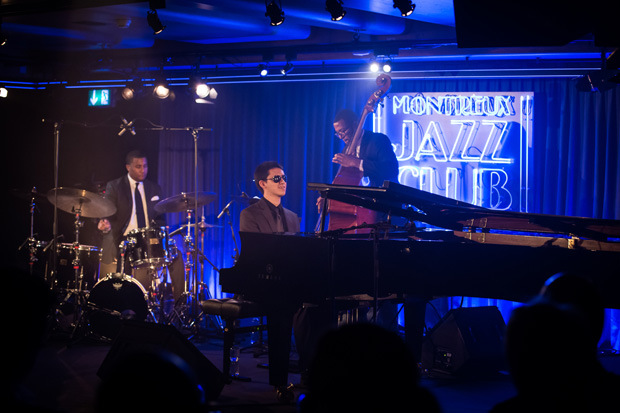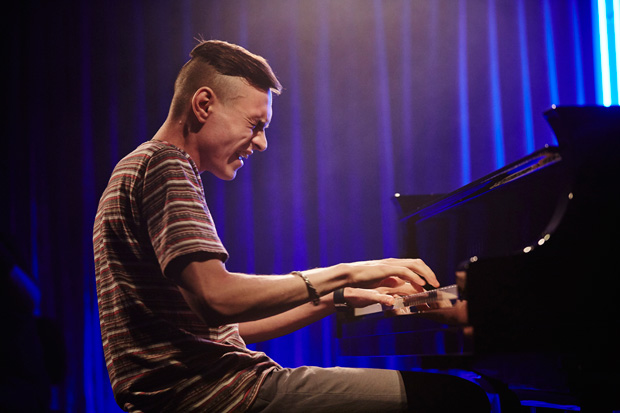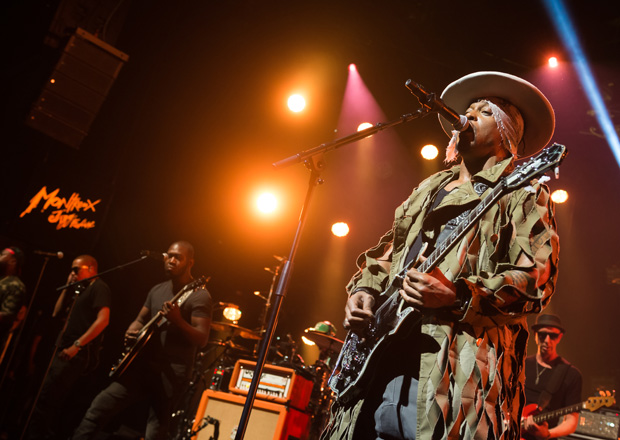Jason Moran, Justin Kauflin and D’Angelo shine at Montreux Jazz Festival
Wednesday, July 22, 2015
Thomas Rees is swept away by glamour, history and stand out performances from Jason Moran, Avishai Cohen, Justin Kauflin, Lorenz Kellhuber, and D’Angelo’s band of jazz heavyweights at this year’s Montreux Jazz Festival There’s something otherworldly about Montreux.

It’s my second year but I’m still giddy with the glamour of it all, the grand old hotels with their wrought iron balconies and canary yellow awnings, the palm trees, and the belle epoch paddle steamers on the lake that announce their arrival with a nostalgic whistle.
The tagline ‘Montreux Riviera’ is bang on. This feels more like the south of France than Switzerland and there’s enough history and romance associated with Montreux to give the Riviera proper a run for its money – not to mention plenty of yachts. Lord Byron used to spend his summers nearby and you’re just an hour’s lazy lakeside stroll from Château de Chillon, a storybook castle that inspired one of his most celebrated works.
That’s before you even get to the festival, which has a mythology and lore of its own. Everyone you can think of has played here and everyone I talk to, from pianist Jason Moran and Israeli bassist Avishai Cohen to Quincy Jones, a long-time friend of Montreux and the man responsible for landing some of its biggest acts, is full of it – raving about the atmosphere or, in Quincy’s case, reminiscing about the time he tried to persuade Aretha Franklin to come over despite her fear of flying. He and festival founder Claude Nobs, who passed away in 2013, came up with an elaborate scheme involving trains, limousines and a cruise ship. Aretha paused a moment before delivering the immortal line “ain’t you guys never heard of the Titanic!”
Franklin did play at Montreux, in 1971, the same year some idiot let off a flare in the middle of a Frank Zappa concert and burnt the Montreux Casino to the ground. Rock band Deep Purple, who were in town to record, saw the blaze from their hotel room and ‘Smoke on the Water’ was born. The ‘Funky Claude’ of the second verse is Nobs himself.
There are hundreds of stories like these and almost as many about Montreux’s expense. It’s true that you could spend a heart-stopping amount of money here. The price of hotel rooms skyrockets during the festival and, even by Swiss standards, the big gigs don’t come cheap. You can run up a sobering drinks bill without even trying, burn through your savings at the street food stalls that line the waterfront or remortgage your house for the privilege of entering the seafood and champagne bar in the lobby, where a nearby stand will do you any kind of sandwhich you want, as long as it’s made with Iberico ham, gravlax, caviar or foie gras.
In what felt like a pathetically tame, middle class re-run of Fear and Loathing in Las Vegas, I took to smuggling bread and hunks of Gruyère from the breakfast buffet at my hotel to save on lunch. After spending six hours in my bag in the blazing sun it was warm to the point of hallucinogenic.
But the expense is only half the story. At times Montreux feels like a festival with a split personality. There are as many studenty types here as there are Swiss bankers with Ferraris double parked outside the Montreux Palace hotel and you could just as easily do this festival on the cheap if you stayed at one of the campsites on the outskirts of town and stocked up on beers at the Co-op. By day the atmosphere is genteel but come midnight, when the waterfront is a blur of neon, the whole place lets its hair down.
It’s also sponsored up to its eyeballs and, while some of those sponsors (Nestle, British American Tobacco Switzerland, Diageo and SOCAR, the State Oil Company of Azerbaijan Republic) are liable to leave a bitter taste in your mouth (or an oily smudge on your conscience), it does mean that there are an astonishing number of free events.
In fact it’s a little overwhelming. I was there for three days, usually crying off around 3am and I felt like I only scratched the surface. I caught a showing of deeply emotional Clark Terry documentary Keep on Keepin’ On hosted by Quincy Jones (Terry’s first every student), who arrived in a pair of elegant silk pyjamas; workshops and talks led by Avishai Cohen and Jason Moran; an uplifting set from the Oakland Interfaith Gospel Choir on the Music in the Park stage and jam sessions of frightening quality – all of them free.
Everything that happens here is recorded for the festival’s UNESCO-listed archives, available via terminals in the lobby so, on top of all that, you can while away the time between gigs watching interviews with Stan Getz and sets by Art Blakey and the Jazz Messengers from the early ‘80s, back when Terence Blanchard and Jean Toussaint were still in short trousers. I never even made it to the edgy, laser-lit Jazz Lab where nubile 20-somethings dance until the sun comes up; to the world music stage, El Mundo; to the jazz boat, the jazz train or to any of the competitions, but I saw more than my fair share of inspiring music.

Avishai Cohen’s New York Division
Cohen and Moran weren’t just in town to give workshops. The bassist was here with his New York Division, a hard grooving six piece that comprises his working trio of pianist Nitai Hershkovits and drummer Daniel Dor, plus a front line made up guitarist Kurt Rosenwinkel, trumpeter Diego Urcola and trombonist Steve Davis, all former collaborators from the Big Apple. Their set felt like joyful reunion, as much a jam session as a gig, full of blazing solos and infectious grooves that lit up the bassist’s back catalogue and expanded upon tracks from his latest trio album, From Darkness.
There were mesmeric vamps and swaggering montunos, mellow brass chorales and rockier episodes, over which Rosenwinkle’s guitar slithered like an electric eel. Both Dor and Hershkovitz were on fire – the latter spinning out vicious, switchback lines – but it was Urcola who got the best reception from the crowd. On trumpet he can shred like Freddie Hubbard while his flugel sound is dusky and effortlessly laid back. All the while, Cohen pouted and weaved, dancing with his bass and cooing over the soloists.
He gave us a handful of thrumming bass features, a surging Afro Cuban finisher and a haunting rendition of ‘Nature Boy’ – the perfect match for his soft-textured vocals. On bass, he may be more restrained than someone like Christian McBride, but he more than makes up for it with the quality of his compositions, not to mention limitless energy, charisma and groove. Here he also proved himself a great facilitator and in the New York Division he’s assembled a truly formidable band.

Jason Moran’s Fats Waller Dance Party
The energy levels were ramped up again the following night for Jason Moran’s Fats Waller Dance Party, which achieved the impossible by getting the conservative Montreux Jazz Club crowd up on their feet – albeit only during the encore. I don’t know how they held out so long. The set was a whirlwind, a gloriously feral assault on the senses that captured the essence of Waller’s music while simultaneously reinventing it almost beyond recognition.
On ‘Honeysuckle Rose’ Lisa Harris’ blurry, intoxicating vocals hovered over a stuttering hip hop backbeat – the contrast all the more disorientating thanks to Leron Thomas’ old school, muted trumpet lines. ‘Ain't Misbehavin’’ got a sultry, R&B refit, anchored by the kind of riff that hangs around in your auditory cortex for days, and ‘Tain’t Nobody’s Business If I Do’ was rendered melancholic to the point of harrowing, underscored by dull, snare drum hits that accentuated the feeling of anguish and disappointment. Moran set out to explore some of the sadness and the trauma behind Waller’s beaming performer persona and he’s nailed it.
The pacing of the set was immaculate too. ‘Two Sleepy People’, a vocal number for Thomas, slowed things down. There was a freewheeling feature for Moran and drummer Charles Haynes, whose power, groove and ability to obscure the barline rivals that of Chris Dave, and in a momentary departure from Waller repertoire, there was a radical recasting of Ornette Coleman’s ‘Lonely Woman’ – like a club remix with exaggerated operatic vocals from Harris and a trippy, electro backing track.
With the band in vibrant fabrics and Moran in a Haitian carnival mask – a hefty Waller head complete with hat and smouldering papier-mâché fag – there’s a strong visual dimension to the performance which heightens the immersion and channels Waller’s theatrical side. The whole thing amounts to a towering feat of imagination.

Justin Kauflin Trio
Every gig at Montreux is a double bill – excellent for raising the profile of emerging artists – and before Moran’s performance I was glad to catch a set from Justin Kauflin, a young American pianist (blind since the age of 11) who’s being hailed by Quincy Jones as the next big thing. Kauflin seemed to have arrived at Montreux in R&B mode (you can hear the influence of Robert Glasper in the way articulates his chords) and his playing was less varied than it is on his debut album, Dedication, where hard bop and classical tropes also reveal themselves. But his trio set, with bassist Chris Smith and drummer Billy Williams, was memorable all the same. Original compositions dedicated to former teachers – among them Mulgrew Miller and Clark Terry – were soulful and heartfelt, punctuated by chocolatey bass solos from Smith and virtuosic bursts from Kauflin – long ribbons of notes in which he proved himself a master of melodic development. On the agitated groove of ‘The Up and Up’ Williams was magisterial and a Beatles cover, ‘A Day In The Life’, was full of pleasing interplay and switches of groove, with a scattering of hip hop beats.

Lorenz Kellhuber
Though it was Kauflin who got the bigger reception from the crowd, the discovery of the festival for me was 25-year-old German pianist Lorenz Kellhuber, who won Montreux’s Parmigiani Piano Solo Competition in 2014. Kellhuber released a trio album, State of Mind, earlier this year, but he took the stage alone to play four long improvisations of astonishing depth and maturity.
There were bluesy episodes and forays into gospel, echoes of ambient rock, exploratory passages lit by quivering stacks of fourths and underwritten by dense classic harmony, and burst of frightening virtuosity. Swirling motifs went on for improbable lengths of time and never seemed to waver (Kellhuber clearly has iron technique) and the whole thing was underscored by serious good taste. There was nothing extraneous. No resort to virtuosity for virtuosity’s sake. Everything was in the service of the music and, with timely switches between line playing and chordal work, the pacing was bang on.
The second half of the set brought covers of Eric Clapton’s ‘Tears in Heaven’, Hendrix’s ‘Little Wing’ and ‘Can’t Find My Way Home’ by Blind Faith and you could here that, even here, Kellhuber was stretching himself, tinkering with the harmony and finding beautiful, unexpected resolutions. The obvious comparison is with Keith Jarrett, who Kellhuber cites as a major influence. He seems similarly swept away by the music – his head continually swaying back and forth. If he goes on to similarly great things I wouldn’t be at all surprised.

D’Angelo and the Vanguard
Though jazz has always been at the heart of Montreux, nowadays the programming is considerably more varied. Many of this year’s headliners have little or nothing to do with the tradition (along with Herbie Hancock and Chick Corea, Lionel Richie, Sam Smith, Portishead and the Chemical Brothers all top the bill). Others are on the fringes, and I couldn’t resist watching a set by the reincarnated D’Angelo – a neo soul pioneer whose influence can be heard in the work of Jacob Collier, and without whom it’s hard to imagine Jarrod Lawson.
He’s just released his first album for 15 years and has assembled a phenomenal band to celebrate. Among others, the 11-piece Vanguard features veteran bassist Pino Palladino, maverick drummer Chris Dave, guitarist Isaiah Sharkey (a member of Dave’s Drumhedz) and trumpeter Keyon Harrold, whose contributions to recent Otis Brown III release The Thought of You are some of the album’s most memorable.
It was an angsty sort of gig. D’Angelo kept us waiting for almost an hour, with half the crowd booing as he took the stage. But by the time he sauntered off again they were eating out of his hand. Mainstream it may be, but this is serious music making. D’Angelo’s vocals ranged from silky and angelic to raw and impassioned and he orchestrated hits with a wave of his hand, à la James Brown. Classics like ‘Brown Sugar’ were fitted out with inventive new horn parts and a raft of new grooves. The band took risks and there was acres of space for the soloists to shine, with Harrold contributing flaring lines, Sharkey leaning towards intricate post bop phrases and Dave getting up to his usual, confoundingly brilliant, rhythmic trickery.
At the height of ‘The Charade’, a furious response to police brutality in the US, with Dave nailing his snare drum and the whole band shredding, the atmosphere was electric. My notebook was a sweaty, ink-smeared mess and I couldn’t have been happier. It felt like history in the making, but that’s nothing new for Montreux. Here it’s just another story in a long list – a footnote in the tale of this glitzy musical Narnia with its powder blue lake and fairy tale castle, a place where an appearance from a pyjama-clad Quincy Jones is nothing out of the ordinary. The festival turns 50 next year, so if you’ve never experienced it, I suggest you go.
– Thomas Rees @ThomasNRees
Photos credits as follows – The Jazz Lab (Credit: 2015 FFJM Marc Ducrest), Cohen (Credit: 2015 FFJM Daniel Balmat), Moran (Credit: 2015 FFJM Marc Ducrest), Kauflin (Credit: 2015 FFJM Marc Ducrest), Kellhuber (Credit: 2015 FFJM Daniel Balmat) and D'Angelo (Credit: 2015 FFJM Lionel Flusin)